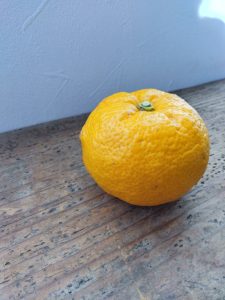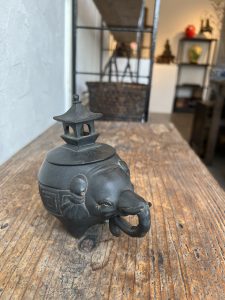今夜はゆず湯が楽しみです(愛知県名古屋市千種区姫池通 骨董買取 古美術風光舎)
2023.12.22
みなさまこんにちは、スタッフTでございます。
今朝も寒かったですね。名古屋も氷点下を観測したようですよ。一気に冬将軍の到来ですね。かじかむ手にブログを綴っている私の隣には黄色いお客様が。

さて、本日は冬至です。
ご存じの通り、一年の中でも昼間がもっとも短くて、夜がもっとも長くなる一日です。冬至は、1年を太陽の動きに合わせて24等分して決められる「二十四節気」のひとつ。
日がもっとも短い冬至を過ぎたら、そこから少しずつ日が長くなっていきます。そのことから冬至は、太陽の力がよみがえり、冬が終わって春に向かう境の日と考えられており、「一陽来復(いちようらいふく)」とも言われます。「太陽が復活する日」「運が向いてくる大事な日」として、世界各地でめでたい日、縁起が良い日とされています。
冬至は「運」が向いてくる大事な日であることから、「ん」がつくものを食べて「運」を呼び込むという風習もあるのをご存じですか?
「かぼちゃ(南瓜:なんきん)」「人参(にんじん)」「蓮根(れんこん)」「銀杏(ぎんなん)」「金柑(きんかん)」「寒天(かんてん)」「うんどん(うどん)」の「ん」が重なる食べ物は、「冬至の七種(ななくさ)」と呼ばれ、特に縁起が良いとされているようです。
その中でもかぼちゃは、本来は夏が旬の野菜ですが、夏に採ったかぼちゃを冬まで保存しておくことで、甘味や栄養価が増すのだそうです。かぼちゃには、健康や美容に必要なβ-カロテンや風邪予防によいビタミンCが豊富なので、厳しい寒さを乗り切る食材としてぴったりです。ホクホクの冬かぼちゃをおいしく食べれば、運をう~んと呼び込めるかもしれません。
また冬至には、古くからゆず湯に入る慣習があります。
ゆず湯に入る理由は、「運が向いてくる大事な日」に由来しています。昔から強い香りは邪気を払うと伝えられています。一年で太陽が出る時間が一番短い冬至の日は、邪気悪霊に気を付けなければならない日ともいわれており、柚子で邪気払いをする目的もあったようです。また、柚子は実をつけるまでに長い年月がかかるため「長年の苦労が実りますように」といった願いを込めたともいわれています。
それから、子どもたちが大好きな「ダジャレ」に由来する理由もあります。冬至=湯治(とうじ)、柚子=融通(ゆうづう)をかけて、「冬至の日はお湯に入って湯治をして、融通よくなりますように」というものです。銭湯の文化が広まった江戸時代に、洒落を好む江戸っ子によって広まったようです。
柚子湯には血行を促進して冷え性を緩和したり、体を温めて風邪を予防したり、果皮に含まれるクエン酸やビタミンCによる美肌効果があると考えられています。柚子の果汁や果皮には多くの栄養が含まれており、お肌に良いと言われているビタミンCの含有量は柑橘類の中でもトップクラスです。
柚子100g中に含まれる果汁のビタミンC含有量は40mgですが、果皮には150mgと特に多く含まれており、ビタミンCは肌の保水性を高め、抗酸化作用を有することから、乾燥肌の予防や老化予防や肌を守るバリア機能の効果が期待できます。
その柚子湯は、柚子の果実を丸のままお湯に浮かべる光景がイメージされますが、柚子の薬効による様々な効果を得るためには、柚子を細かく刻んでネットなど袋に入れ、湯に浮かべるのがよいようです。この柚子入りの袋で体をこすると、柚子独特のよい香りの癒し効果とともに、肌を滑らかにする効果があるそうです。
感染症が流行る季節でもあるので、ゆずの良い香りのお風呂で、リラックスして温まることも感染予防になりそうです。
私のお隣からも、ゆずの爽やかな香りがしてきました。これから寒さが一段と厳しくなりますので、柚子湯に入って芯から身体を温め、風邪知らずでいきたいものですね。
ではでは、また。
Hello everyone, this is Staff T.
It was cold again this morning. It was below freezing in Nagoya as well. The winter army has arrived at once, hasn’t it? I am writing this blog with cold hands, and there is a yellow customer next to me.
Today is the winter solstice.
As you know, it is the day of the year when daytime is the shortest and nighttime is the longest. The Winter Solstice is one of the 24 solar terms, which are determined by dividing the year into 24 equal parts according to the movement of the sun.
After the winter solstice, when the days are shortest, the days gradually get longer. The Winter Solstice is therefore considered to be the day when the sun’s power revives and the winter ends, marking the border of spring, and is also called “Ichiyo raibetsu” (meaning “the sun comes back”). It is also called “Ichiyo-raibetsu,” or “the day when the sun comes back to life” or “an important day when luck comes back to us,” and is considered a day of happiness and good fortune in many parts of the world.
Since the Winter Solstice is an important day that brings luck, do you know that there is a custom to eat something with “n” in it to bring luck?
The foods with “N” in them are called “Nanakusa” (seven kinds of foods on the Winter Solstice) and are believed to be especially auspicious.
Among them, pumpkin is a vegetable that is originally in season in summer. However, it is said that the sweetness and nutritional value of pumpkin increases when pumpkin picked in summer is preserved until winter. Kabocha is rich in β-carotene, which is necessary for health and beauty, and vitamin C, which is good for preventing colds, making it a perfect food for surviving the harsh cold weather. Eating a delicious winter pumpkin may bring you good luck.
There is an old custom of taking a yuzu bath on the winter solstice.
The reason for taking a yuzu bath is derived from the fact that it is an important day for good luck. It has long been said that the strong fragrance of yuzu dispels evil spirits. The day of the winter solstice, when the sun comes out for the shortest time of the year, is also said to be a day to watch out for evil spirits, and yuzu was used to ward off evil spirits. Yuzu is also said to be a symbol of hope that all the years of hard work will bear fruit, as it takes many years for the fruit to ripen.
Another reason for the name is derived from a “pun” that children love. The pun is based on the combination of the words “toji” (winter solstice) and “yuzu” (yuzu), meaning “to take a hot bath on the day of the winter solstice and have a hot-spring cure to improve one’s health. It was popularized during the Edo period (1603-1867), when the culture of public baths was spreading, by the Edo kko (people of the Edo period) who liked to be fashionable.
Yuzu baths are believed to promote blood circulation, alleviate sensitivity to cold, warm the body and prevent colds, and beautify the skin due to the citric acid and vitamin C contained in the rind. The juice and peel of yuzu contain many nutrients, and the amount of vitamin C, which is said to be good for the skin, is one of the highest among citrus fruits.
The juice in 100 g of yuzu contains 40 mg of vitamin C, but the peel contains particularly high amounts of vitamin C (150 mg). Vitamin C improves the water retention properties of the skin and has antioxidant properties, so it is expected to help prevent dry skin, prevent aging, and protect the skin barrier function.
Yuzuyu is usually imagined as a scene where the whole yuzu fruit is floated in hot water. However, in order to obtain the various medicinal effects of yuzu, it is better to chop the yuzu finely and put it in a bag such as a net and float it in the hot water. Rubbing the body with this bag of yuzu is said to have the effect of smoothing the skin as well as the healing effect of yuzu’s distinctive fragrance.
Since it is the season when infectious diseases are prevalent, relaxing and warming yourself in a bath with the good scent of yuzu may also be a good way to prevent infection.
I could smell the fresh scent of yuzu coming from my neighbor. As the cold weather is getting colder and colder, I would like to take a yuzu bath to warm up my body from the core and avoid catching a cold.
See you soon.
*******************
ご実家の整理やお片付けなどをされている方のご相談などが多くございます。
寒さ厳しい季節ですので、お片付けなどくれぐれもご無理のないようになさってくださいませ。
風光舎では古美術品や骨董品の他にも絵画や宝石、趣味のお品など様々なジャンルのものを買受しております。
お片付けをされていて、こういうものでもいいのかしらと迷われているものでも、どうぞお気軽にご相談下さいませ。
また風光舎は、出張買取も強化しております。ご近所はもちろん、愛知県内、岐阜県、三重県その他の県へも出張いたします。
まずは、お電話お待ちしております。
愛知県名古屋市千種区姫池通
骨董 買取
【古美術 風光舎 名古屋店】
TEL052(734)8444
10:00-17:00 OPEN
#出張買取#骨董#古美術#骨董品#絵画#版画#茶道具#刀剣#彫刻


